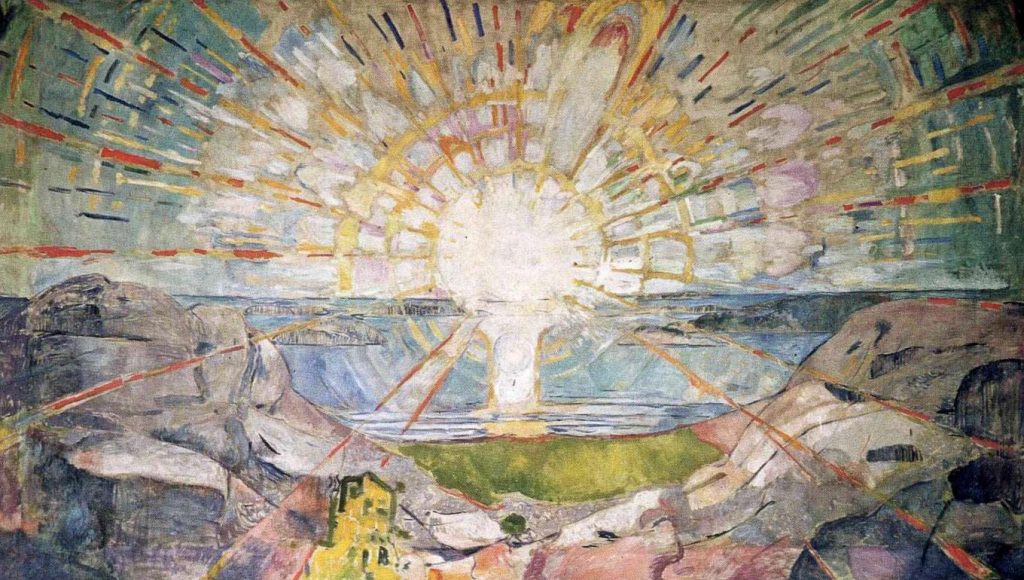“Children of the Sun,” nonfiction by Matt Jones, appeared in the Summer 2018 issue of MQR.
When was the first time you saw the sun?
Not its winding tendrils, or its luminous glow, or even its radiant essence shining down upon your skin. Not its glare, or its intensity, or its resplendent effulgence — but it. Its hopes, and dreams, and fears, and greatest regrets. Its spots. Its flares. Its magnetic loops and coronal mass ejections. Both its countenance and penetralia, its shape and depth.
When, exactly, was the first time?
~
The first photograph of the sun was captured on April 2, 1845 by Leon Foucault and Louis Fizeau. It wasn’t really a photograph, but a daguerreotype, which meant that the image was produced by first treating a sheet of silver-plated copper with silver iodide and bromine, then exposing it inside a camera, and finally fuming the sheet with mercury vapor.
This particular image of the sun does not look like the sun, but rather like a relative of the moon. Maybe a first cousin you only see once a year during the holidays — pale, round, and vaguely featureless in a familiar kind of way. A celestial body that you might practice kissing on until you get good enough to plant your lips on Auriga, Centaurus, Ophiuchus, or that most beautiful of chained maidens, the constellation Andromeda.
But what could you really expect from a photograph of the sun taken in 1845? It was in that same year that Rufus M. Porter published the first-ever issue of Scientific American, which mentions Signor Muzio Muzzi’s Traveling Balloon, the first airship of its kind designed to navigate wind without oars, wheels, or sails. On page two, there is mention of a slave from Charleston, South Carolina who saved a white boy from drowning in a river, and a rattlesnake that swallowed a mole only to have the rodent gnaw its way back out of the reptile’s stomach. The magazine features a list of recent inventions: an improved cotton gin, a new type of Indian rubber, and the daguerreotype camera.
This first issue of the Scientific American includes an article explaining how the daguerreotype works, as well as numerous ads for private sellers. Optician John Roach of New York was selling kits of chemicals and plates of good quality, “cheaper than from any other establishment.” Frederick Langenheim of Philadelphia and Erastus W. Pratt also claimed to offer quality equipment at the lowest prices.
Beneath the article on Signor Muzzi’s contribution to aerial locomotion, there’s a blurb about Dr. Peter Parker’s most recent trip to China. Dr. Parker was both a missionary and an ophthalmologist who founded Canton Hospital in the most populous city in the province of Guangdong. His greatest concern as a medical missionary was helping the people of Canton see better. He operated on thousands of cases of cataracts, leucoma, staphyloma, night blindness, and pterygium — a condition thought to stem from too much direct exposure to the sun’s ultraviolet radiation. As a missionary, he considered the Chinese to be only partially civilized, a society of idol worshippers. The ophthalmologist wanted nothing more than to fix their sight and show them the light — not the kind of light that wounds eyes, but the kind that cleanses souls. It has long been said that Dr. Peter Parker “opened China to the gospel at the point of a lancet.”
To continue reading, purchase MQR 57:3 or consider a one-year subscription.

Image: Munch, Edvard. “The Sun.” 1911-16. Oil on canvas. University of Oslo, Norway.
Matt Jones is a graduate of the University of Alabama MFA program. His prose has appeared or is forthcoming in The Southern Review, The Atlantic, Ruminate, Post Road, and other publications. He has been awarded an Ohio Arts Council Individual Excellence Award and will be a writer-in-residence at Willowtail Springs and The Leopold Writing Program in the summer of 2018. Find out more at mattjonesfiction.com, or follow him on Twitter @tinyarmoredone.




